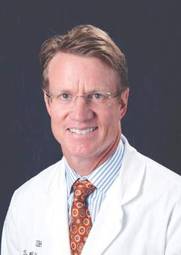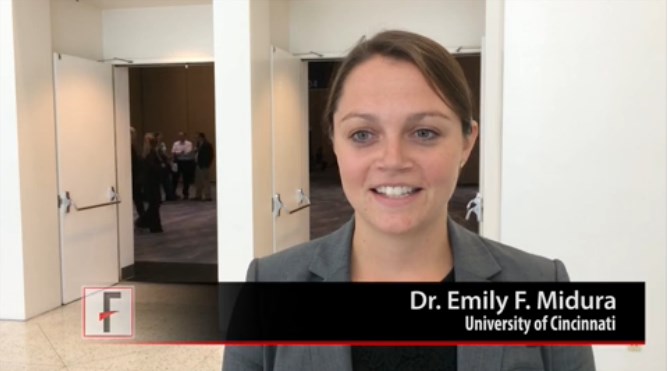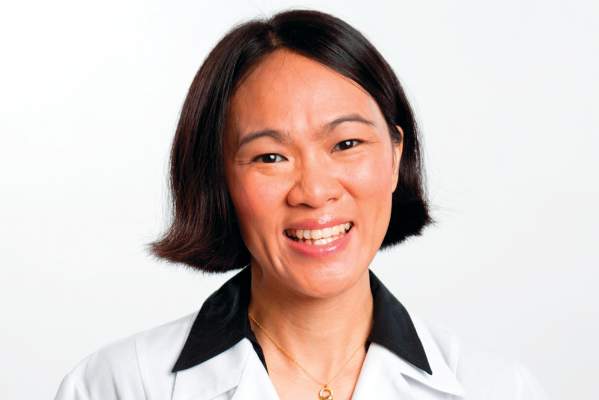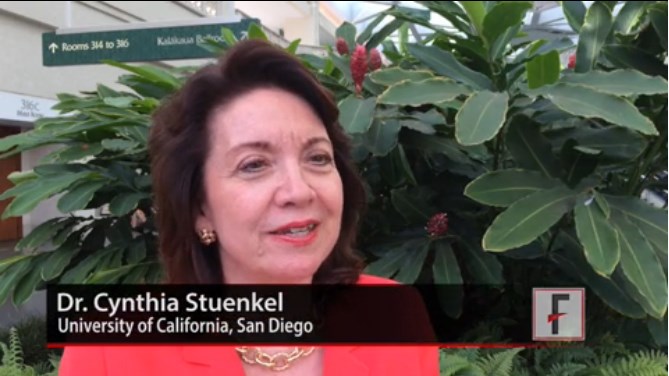User login
Achieving sustained response key to successful HCV treatment
BOSTON – Risks for mortality, hepatocellular carcinoma, and liver transplantations were significantly lower in patients with hepatitis C who achieved a sustained virologic response after treatment, compared with patients without a sustained response, in a meta-analysis of long-term follow-up data on 23,309 patients.
In patients with a sustained virologic response (SVR), the risk of death was 62%-84% lower, the risk of developing hepatocellular carcinoma was 68%-79% lower, and the risk of liver transplantation was 90% lower, compared with patients who did not achieve a SVR, Andrew M. Hill, Ph.D., and his associates reported at the annual meeting of the American Association for the Study of Liver Diseases.
The cohort included 15,067 patients with hepatitis C without cirrhosis, HIV, or prior transplantation; 4,987 patients with hepatitis C and cirrhosis; 1,170 patients with hepatitis C who had undergone liver transplantation; and 2,085 patients coinfected with hepatitis C and HIV.
Treatment consisted primarily of pegylated interferon plus ribavirin. “These analyses need to be repeated for studies of direct acting antivirals,” said Dr. Hill of the University of Liverpool, England.
In the current study, SVR was associated with a 62% reduction in the risk of death in the general group of mono-infected patients without cirrhosis or transplantation, an 84% reduction in patients with cirrhosis, and a 73% reduction in those coinfected with HIV, multivariate analyses showed.
The 5-year risk of all-cause mortality was 4.5% after SVR and 10.5% with no SVR in the general group of patients with HCV. In those with cirrhosis, mortality rates were 3.6% after SVR or 11.3% with no SVR. In patients who also had HIV, mortality rates were 1.3% after SVR and 10% with no SVR, Dr. Hill reported.
The 5-year risk of developing hepatocellular carcinoma as 2.9% after SVR and 9.3% with no SVR in the general group with HCV. In patients with cirrhosis, hepatocellular carcinoma rates were 5.3% with SVR and 13.9% with no SVR. In patients who had HIV, hepatocellular carcinoma rates were 0.9% after SVR and 10% with no SVR.
Reinfection with HCV can complicate the results of treatment, Dr. Hill said. The 5-year reinfection rates were 0.9% in low-risk patients, 8.2% in IV drug users or prisoners, and 23.6% in patients coinfected with HIV.
“The cost-effectiveness of treatment of hepatitis C depends on the extent of reductions in the risk of liver transplantation, hepatocellular carcinoma, and all-cause mortality,” he said.
The World Health Organization and UNITAID funded the study. Dr. Hill reported financial associations with Janssen Pharmaceuticals.
On Twitter @sherryboschert
BOSTON – Risks for mortality, hepatocellular carcinoma, and liver transplantations were significantly lower in patients with hepatitis C who achieved a sustained virologic response after treatment, compared with patients without a sustained response, in a meta-analysis of long-term follow-up data on 23,309 patients.
In patients with a sustained virologic response (SVR), the risk of death was 62%-84% lower, the risk of developing hepatocellular carcinoma was 68%-79% lower, and the risk of liver transplantation was 90% lower, compared with patients who did not achieve a SVR, Andrew M. Hill, Ph.D., and his associates reported at the annual meeting of the American Association for the Study of Liver Diseases.
The cohort included 15,067 patients with hepatitis C without cirrhosis, HIV, or prior transplantation; 4,987 patients with hepatitis C and cirrhosis; 1,170 patients with hepatitis C who had undergone liver transplantation; and 2,085 patients coinfected with hepatitis C and HIV.
Treatment consisted primarily of pegylated interferon plus ribavirin. “These analyses need to be repeated for studies of direct acting antivirals,” said Dr. Hill of the University of Liverpool, England.
In the current study, SVR was associated with a 62% reduction in the risk of death in the general group of mono-infected patients without cirrhosis or transplantation, an 84% reduction in patients with cirrhosis, and a 73% reduction in those coinfected with HIV, multivariate analyses showed.
The 5-year risk of all-cause mortality was 4.5% after SVR and 10.5% with no SVR in the general group of patients with HCV. In those with cirrhosis, mortality rates were 3.6% after SVR or 11.3% with no SVR. In patients who also had HIV, mortality rates were 1.3% after SVR and 10% with no SVR, Dr. Hill reported.
The 5-year risk of developing hepatocellular carcinoma as 2.9% after SVR and 9.3% with no SVR in the general group with HCV. In patients with cirrhosis, hepatocellular carcinoma rates were 5.3% with SVR and 13.9% with no SVR. In patients who had HIV, hepatocellular carcinoma rates were 0.9% after SVR and 10% with no SVR.
Reinfection with HCV can complicate the results of treatment, Dr. Hill said. The 5-year reinfection rates were 0.9% in low-risk patients, 8.2% in IV drug users or prisoners, and 23.6% in patients coinfected with HIV.
“The cost-effectiveness of treatment of hepatitis C depends on the extent of reductions in the risk of liver transplantation, hepatocellular carcinoma, and all-cause mortality,” he said.
The World Health Organization and UNITAID funded the study. Dr. Hill reported financial associations with Janssen Pharmaceuticals.
On Twitter @sherryboschert
BOSTON – Risks for mortality, hepatocellular carcinoma, and liver transplantations were significantly lower in patients with hepatitis C who achieved a sustained virologic response after treatment, compared with patients without a sustained response, in a meta-analysis of long-term follow-up data on 23,309 patients.
In patients with a sustained virologic response (SVR), the risk of death was 62%-84% lower, the risk of developing hepatocellular carcinoma was 68%-79% lower, and the risk of liver transplantation was 90% lower, compared with patients who did not achieve a SVR, Andrew M. Hill, Ph.D., and his associates reported at the annual meeting of the American Association for the Study of Liver Diseases.
The cohort included 15,067 patients with hepatitis C without cirrhosis, HIV, or prior transplantation; 4,987 patients with hepatitis C and cirrhosis; 1,170 patients with hepatitis C who had undergone liver transplantation; and 2,085 patients coinfected with hepatitis C and HIV.
Treatment consisted primarily of pegylated interferon plus ribavirin. “These analyses need to be repeated for studies of direct acting antivirals,” said Dr. Hill of the University of Liverpool, England.
In the current study, SVR was associated with a 62% reduction in the risk of death in the general group of mono-infected patients without cirrhosis or transplantation, an 84% reduction in patients with cirrhosis, and a 73% reduction in those coinfected with HIV, multivariate analyses showed.
The 5-year risk of all-cause mortality was 4.5% after SVR and 10.5% with no SVR in the general group of patients with HCV. In those with cirrhosis, mortality rates were 3.6% after SVR or 11.3% with no SVR. In patients who also had HIV, mortality rates were 1.3% after SVR and 10% with no SVR, Dr. Hill reported.
The 5-year risk of developing hepatocellular carcinoma as 2.9% after SVR and 9.3% with no SVR in the general group with HCV. In patients with cirrhosis, hepatocellular carcinoma rates were 5.3% with SVR and 13.9% with no SVR. In patients who had HIV, hepatocellular carcinoma rates were 0.9% after SVR and 10% with no SVR.
Reinfection with HCV can complicate the results of treatment, Dr. Hill said. The 5-year reinfection rates were 0.9% in low-risk patients, 8.2% in IV drug users or prisoners, and 23.6% in patients coinfected with HIV.
“The cost-effectiveness of treatment of hepatitis C depends on the extent of reductions in the risk of liver transplantation, hepatocellular carcinoma, and all-cause mortality,” he said.
The World Health Organization and UNITAID funded the study. Dr. Hill reported financial associations with Janssen Pharmaceuticals.
On Twitter @sherryboschert
AT THE LIVER MEETING 2014
Key clinical point: Achieving a sustained virologic response to hepatitis C treatment improved long-term outcomes.
Major finding: Achieving a sustained virologic response was associated with a 62%-84% lower risk of death.
Data source: A meta-analysis of data on 23,309 patients with hepatitis C infection in 129 studies.
Disclosures: The World Health Organization and UNITAID funded the study. Dr. Hill reported ties with Janssen Pharmaceuticals.
VIDEO: Risks for anastomotic leak after colectomy identified
SAN FRANCISCO– A large retrospective study identified risk factors for anastomotic leak within 30 days of colectomy.
The analysis of data on 13,684 patients looked at a multicenter cohort, compared with previous smaller studies that generally focused on single institutions, Dr. Emily F. Midura and her associates reported at the annual clinical congress of the American College of Surgeons.
In a video interview at the meeting, Dr. Midura described the risk factors identified in the study.
The 4% of patients who developed a leak averaged 13 days in the hospital, compared with 8 days for patients with no leak, said Dr. Midura of the University of Cincinnati. A total of 6% of patients who developed an anastomotic leak died, compared with a 2% mortality rate in patients without a leak.
Indications for colectomy included cancer in 42% of patients, diverticulitis in 23%, inflammatory bowel disease in 6%, and other reasons in the rest of the cohort.
Dr. Midura reported having no financial disclosures.
The video associated with this article is no longer available on this site. Please view all of our videos on the MDedge YouTube channel
On Twitter @sherryboschert
SAN FRANCISCO– A large retrospective study identified risk factors for anastomotic leak within 30 days of colectomy.
The analysis of data on 13,684 patients looked at a multicenter cohort, compared with previous smaller studies that generally focused on single institutions, Dr. Emily F. Midura and her associates reported at the annual clinical congress of the American College of Surgeons.
In a video interview at the meeting, Dr. Midura described the risk factors identified in the study.
The 4% of patients who developed a leak averaged 13 days in the hospital, compared with 8 days for patients with no leak, said Dr. Midura of the University of Cincinnati. A total of 6% of patients who developed an anastomotic leak died, compared with a 2% mortality rate in patients without a leak.
Indications for colectomy included cancer in 42% of patients, diverticulitis in 23%, inflammatory bowel disease in 6%, and other reasons in the rest of the cohort.
Dr. Midura reported having no financial disclosures.
The video associated with this article is no longer available on this site. Please view all of our videos on the MDedge YouTube channel
On Twitter @sherryboschert
SAN FRANCISCO– A large retrospective study identified risk factors for anastomotic leak within 30 days of colectomy.
The analysis of data on 13,684 patients looked at a multicenter cohort, compared with previous smaller studies that generally focused on single institutions, Dr. Emily F. Midura and her associates reported at the annual clinical congress of the American College of Surgeons.
In a video interview at the meeting, Dr. Midura described the risk factors identified in the study.
The 4% of patients who developed a leak averaged 13 days in the hospital, compared with 8 days for patients with no leak, said Dr. Midura of the University of Cincinnati. A total of 6% of patients who developed an anastomotic leak died, compared with a 2% mortality rate in patients without a leak.
Indications for colectomy included cancer in 42% of patients, diverticulitis in 23%, inflammatory bowel disease in 6%, and other reasons in the rest of the cohort.
Dr. Midura reported having no financial disclosures.
The video associated with this article is no longer available on this site. Please view all of our videos on the MDedge YouTube channel
On Twitter @sherryboschert
AT THE ACS CLINICAL CONGRESS
Diet, exercise boost ovulation in PCOS
HONOLULU – Preconception diet and exercise, by themselves or in combination with oral contraceptives, improved ovulation rates, compared with birth control pills alone, in a randomized study of 149 women with polycystic ovary syndrome.
The study randomized women with polycystic ovary syndrome (PCOS) who wanted to conceive to 16 weeks of either oral contraceptive pills; lifestyle modification consisting of increased physical activity, brief behavior modification lessons, a weight-loss medication, and caloric restriction using meal replacements; or a combination of both lifestyle interventions and oral contraceptives. All subjects then received four monitored cycles of ovulation induction with clomiphene.
Ovulation rates in the lifestyle intervention group and the combination therapy group were significantly higher (60% and 67%, respectively) than in the oral contraceptives group (46%), Dr. Richard S. Legro and his associates reported in a prize-winning presentation at the 2014 annual meeting of the American Society for Reproductive Medicine.
“Looking at the relative rate of ovulation, there was a 30%-50% improved rate of ovulation if the patient had undergone a preconception lifestyle modification,” compared with oral contraceptives alone, said Dr. Legro, professor of ob.gyn. at Pennsylvania State University in Hershey.
There was a trend toward higher live birth rates in the lifestyle intervention group (26%) and the oral contraceptives group (12%, P = .05), with the live birth rate in the combination group nearing that of the lifestyle intervention group (24%).
Investigators stopped the study before enrolling its goal of 248 women after the two groups with lifestyle intervention separated from the oral contraceptives group and an interim analysis concluded that further data would be unlikely to show a significant difference in results between the two groups employing lifestyle interventions.
Women in the combination therapy group lost 6.5% of body weight on average, compared with a 6.2% loss in the lifestyle interventions group and a 1% loss on oral contraceptives. The weight loss goal was 7% of body weight.
Dr. Legro said he was surprised by marked exacerbation of glucose intolerance in women on oral contraceptives that was ameliorated by lifestyle interventions. After the 16 weeks of preinduction treatment, changes in oral glucose tolerance test areas under the curve showed significant differences between the oral contraceptives group (a mean increase of 24 mg/dL/hour) and the lifestyle modifications group (a decrease of 1 mg/dL per hour) or the combination therapy group (a decrease of 17 mg/dL/hour).
The oral contraceptives group also showed trends toward increased blood pressure and fasting glucose levels plus a significant increase in triglyceride levels. The risk for developing metabolic syndrome during the 16 weeks of treatment more than doubled in the oral contraceptives group, compared with a statistically nonsignificant 20% increased risk in the lifestyle interventions group and a nonsignificant 30% decrease in risk in the combination therapy group, he reported.
The continuous oral contraceptive was ethinyl estradiol 10 mcg/norethindrone acetate 1 mg under the brand name LoEstrin 1/20.
The lifestyle modifications involved meal replacements for all three meals per day using fresh vegetables and fruit for a 500 kcal/day deficit. The goal for physical activity was 150 minutes per week, and the monthly behavioral modification lessons were adapted from the Diabetes Prevention Program. Participants with a body mass index of at least 30 received 5-15 mg/day of the antiobesity drug sibutramine until it was removed from the market, after which obese participants received 60 mg of orlistat with meals.
“Is it worth doing all this?” Dr. Legro asked. To answer that question, he and his associates conducted a post-hoc analysis comparing the results from the lifestyle modifications or combination therapy groups with results from the Pregnancy in Polycystic Ovary Syndrome II (PPCOS II) study of clomiphene citrate or letrozole for ovulation induction without any pretreatment.
Cumulative ovulation rates were 40%-50% higher in the current study’s groups that included lifestyle interventions than in the PPCOS II study’s clomiphene group. The likelihood of a live birth more than doubled in the current study’s groups that included lifestyle interventions, compared with the PPCOS II clomiphene group.
The lifestyle interventions treatment “is very reproducible. It’s simple. It’s safe, and it’s well tolerated,” he said. “Oral contraceptive pills pretreatment likely offers little benefit versus immediate treatment with ovulation induction.”
One serious adverse event in the current study occurred in the oral contraceptive group, an episode of menorrhagia that sent the patient to an emergency department.
Concurrent lifestyle modification should be recommended for overweight or obese women with PCOS who are taking oral contraceptives, whether or not they are seeking fertility treatment, Dr. Legro said.
The National Institutes of Health funded the study. Dr. Legro reported financial associations with AstraZeneca, Euroscreen, Takeda Pharmaceuticals, and Ferring Pharmaceuticals. One of his associates reported financial associations with BAROnova and EnteroMedics.
On Twitter @sherryboschert
These findings emphasize the importance of lifestyle intervention in women with PCOS who are trying to have children. This reasonably large study found that diet and exercise offer advantages to women with PCOS, not only in reversing some of the metabolic effects of PCOS, but also in higher ovulation rates and trends toward improved pregnancy rates.

|
Bradley J. Van Voorhis |
It’s also noteworthy that simply putting women on birth control pills alone had some negative effects on glucose metabolism and the risk for metabolic syndrome. So, the other significant message is that it’s probably not wise to simply place women with PCOS on oral contraceptives alone, and oral contraceptive therapy should be done in conjunction with lifestyle interventions.
The findings are practice changing in that they’ll motivate me to always counsel patients with PCOS who are starting oral contraceptives on the potential for adverse effects and the need for dietary control and weight loss. It was surprising to me, the effect of a relatively short course of birth control pills on glucose metabolism and metabolic syndrome.
Dr. Bradley Van Voorhis, professor of medicine and director of the division of reproductive endocrinology and infertility at the University of Iowa, Iowa City, made these comments in an interview. He reported having no financial disclosures.
These findings emphasize the importance of lifestyle intervention in women with PCOS who are trying to have children. This reasonably large study found that diet and exercise offer advantages to women with PCOS, not only in reversing some of the metabolic effects of PCOS, but also in higher ovulation rates and trends toward improved pregnancy rates.

|
Bradley J. Van Voorhis |
It’s also noteworthy that simply putting women on birth control pills alone had some negative effects on glucose metabolism and the risk for metabolic syndrome. So, the other significant message is that it’s probably not wise to simply place women with PCOS on oral contraceptives alone, and oral contraceptive therapy should be done in conjunction with lifestyle interventions.
The findings are practice changing in that they’ll motivate me to always counsel patients with PCOS who are starting oral contraceptives on the potential for adverse effects and the need for dietary control and weight loss. It was surprising to me, the effect of a relatively short course of birth control pills on glucose metabolism and metabolic syndrome.
Dr. Bradley Van Voorhis, professor of medicine and director of the division of reproductive endocrinology and infertility at the University of Iowa, Iowa City, made these comments in an interview. He reported having no financial disclosures.
These findings emphasize the importance of lifestyle intervention in women with PCOS who are trying to have children. This reasonably large study found that diet and exercise offer advantages to women with PCOS, not only in reversing some of the metabolic effects of PCOS, but also in higher ovulation rates and trends toward improved pregnancy rates.

|
Bradley J. Van Voorhis |
It’s also noteworthy that simply putting women on birth control pills alone had some negative effects on glucose metabolism and the risk for metabolic syndrome. So, the other significant message is that it’s probably not wise to simply place women with PCOS on oral contraceptives alone, and oral contraceptive therapy should be done in conjunction with lifestyle interventions.
The findings are practice changing in that they’ll motivate me to always counsel patients with PCOS who are starting oral contraceptives on the potential for adverse effects and the need for dietary control and weight loss. It was surprising to me, the effect of a relatively short course of birth control pills on glucose metabolism and metabolic syndrome.
Dr. Bradley Van Voorhis, professor of medicine and director of the division of reproductive endocrinology and infertility at the University of Iowa, Iowa City, made these comments in an interview. He reported having no financial disclosures.
HONOLULU – Preconception diet and exercise, by themselves or in combination with oral contraceptives, improved ovulation rates, compared with birth control pills alone, in a randomized study of 149 women with polycystic ovary syndrome.
The study randomized women with polycystic ovary syndrome (PCOS) who wanted to conceive to 16 weeks of either oral contraceptive pills; lifestyle modification consisting of increased physical activity, brief behavior modification lessons, a weight-loss medication, and caloric restriction using meal replacements; or a combination of both lifestyle interventions and oral contraceptives. All subjects then received four monitored cycles of ovulation induction with clomiphene.
Ovulation rates in the lifestyle intervention group and the combination therapy group were significantly higher (60% and 67%, respectively) than in the oral contraceptives group (46%), Dr. Richard S. Legro and his associates reported in a prize-winning presentation at the 2014 annual meeting of the American Society for Reproductive Medicine.
“Looking at the relative rate of ovulation, there was a 30%-50% improved rate of ovulation if the patient had undergone a preconception lifestyle modification,” compared with oral contraceptives alone, said Dr. Legro, professor of ob.gyn. at Pennsylvania State University in Hershey.
There was a trend toward higher live birth rates in the lifestyle intervention group (26%) and the oral contraceptives group (12%, P = .05), with the live birth rate in the combination group nearing that of the lifestyle intervention group (24%).
Investigators stopped the study before enrolling its goal of 248 women after the two groups with lifestyle intervention separated from the oral contraceptives group and an interim analysis concluded that further data would be unlikely to show a significant difference in results between the two groups employing lifestyle interventions.
Women in the combination therapy group lost 6.5% of body weight on average, compared with a 6.2% loss in the lifestyle interventions group and a 1% loss on oral contraceptives. The weight loss goal was 7% of body weight.
Dr. Legro said he was surprised by marked exacerbation of glucose intolerance in women on oral contraceptives that was ameliorated by lifestyle interventions. After the 16 weeks of preinduction treatment, changes in oral glucose tolerance test areas under the curve showed significant differences between the oral contraceptives group (a mean increase of 24 mg/dL/hour) and the lifestyle modifications group (a decrease of 1 mg/dL per hour) or the combination therapy group (a decrease of 17 mg/dL/hour).
The oral contraceptives group also showed trends toward increased blood pressure and fasting glucose levels plus a significant increase in triglyceride levels. The risk for developing metabolic syndrome during the 16 weeks of treatment more than doubled in the oral contraceptives group, compared with a statistically nonsignificant 20% increased risk in the lifestyle interventions group and a nonsignificant 30% decrease in risk in the combination therapy group, he reported.
The continuous oral contraceptive was ethinyl estradiol 10 mcg/norethindrone acetate 1 mg under the brand name LoEstrin 1/20.
The lifestyle modifications involved meal replacements for all three meals per day using fresh vegetables and fruit for a 500 kcal/day deficit. The goal for physical activity was 150 minutes per week, and the monthly behavioral modification lessons were adapted from the Diabetes Prevention Program. Participants with a body mass index of at least 30 received 5-15 mg/day of the antiobesity drug sibutramine until it was removed from the market, after which obese participants received 60 mg of orlistat with meals.
“Is it worth doing all this?” Dr. Legro asked. To answer that question, he and his associates conducted a post-hoc analysis comparing the results from the lifestyle modifications or combination therapy groups with results from the Pregnancy in Polycystic Ovary Syndrome II (PPCOS II) study of clomiphene citrate or letrozole for ovulation induction without any pretreatment.
Cumulative ovulation rates were 40%-50% higher in the current study’s groups that included lifestyle interventions than in the PPCOS II study’s clomiphene group. The likelihood of a live birth more than doubled in the current study’s groups that included lifestyle interventions, compared with the PPCOS II clomiphene group.
The lifestyle interventions treatment “is very reproducible. It’s simple. It’s safe, and it’s well tolerated,” he said. “Oral contraceptive pills pretreatment likely offers little benefit versus immediate treatment with ovulation induction.”
One serious adverse event in the current study occurred in the oral contraceptive group, an episode of menorrhagia that sent the patient to an emergency department.
Concurrent lifestyle modification should be recommended for overweight or obese women with PCOS who are taking oral contraceptives, whether or not they are seeking fertility treatment, Dr. Legro said.
The National Institutes of Health funded the study. Dr. Legro reported financial associations with AstraZeneca, Euroscreen, Takeda Pharmaceuticals, and Ferring Pharmaceuticals. One of his associates reported financial associations with BAROnova and EnteroMedics.
On Twitter @sherryboschert
HONOLULU – Preconception diet and exercise, by themselves or in combination with oral contraceptives, improved ovulation rates, compared with birth control pills alone, in a randomized study of 149 women with polycystic ovary syndrome.
The study randomized women with polycystic ovary syndrome (PCOS) who wanted to conceive to 16 weeks of either oral contraceptive pills; lifestyle modification consisting of increased physical activity, brief behavior modification lessons, a weight-loss medication, and caloric restriction using meal replacements; or a combination of both lifestyle interventions and oral contraceptives. All subjects then received four monitored cycles of ovulation induction with clomiphene.
Ovulation rates in the lifestyle intervention group and the combination therapy group were significantly higher (60% and 67%, respectively) than in the oral contraceptives group (46%), Dr. Richard S. Legro and his associates reported in a prize-winning presentation at the 2014 annual meeting of the American Society for Reproductive Medicine.
“Looking at the relative rate of ovulation, there was a 30%-50% improved rate of ovulation if the patient had undergone a preconception lifestyle modification,” compared with oral contraceptives alone, said Dr. Legro, professor of ob.gyn. at Pennsylvania State University in Hershey.
There was a trend toward higher live birth rates in the lifestyle intervention group (26%) and the oral contraceptives group (12%, P = .05), with the live birth rate in the combination group nearing that of the lifestyle intervention group (24%).
Investigators stopped the study before enrolling its goal of 248 women after the two groups with lifestyle intervention separated from the oral contraceptives group and an interim analysis concluded that further data would be unlikely to show a significant difference in results between the two groups employing lifestyle interventions.
Women in the combination therapy group lost 6.5% of body weight on average, compared with a 6.2% loss in the lifestyle interventions group and a 1% loss on oral contraceptives. The weight loss goal was 7% of body weight.
Dr. Legro said he was surprised by marked exacerbation of glucose intolerance in women on oral contraceptives that was ameliorated by lifestyle interventions. After the 16 weeks of preinduction treatment, changes in oral glucose tolerance test areas under the curve showed significant differences between the oral contraceptives group (a mean increase of 24 mg/dL/hour) and the lifestyle modifications group (a decrease of 1 mg/dL per hour) or the combination therapy group (a decrease of 17 mg/dL/hour).
The oral contraceptives group also showed trends toward increased blood pressure and fasting glucose levels plus a significant increase in triglyceride levels. The risk for developing metabolic syndrome during the 16 weeks of treatment more than doubled in the oral contraceptives group, compared with a statistically nonsignificant 20% increased risk in the lifestyle interventions group and a nonsignificant 30% decrease in risk in the combination therapy group, he reported.
The continuous oral contraceptive was ethinyl estradiol 10 mcg/norethindrone acetate 1 mg under the brand name LoEstrin 1/20.
The lifestyle modifications involved meal replacements for all three meals per day using fresh vegetables and fruit for a 500 kcal/day deficit. The goal for physical activity was 150 minutes per week, and the monthly behavioral modification lessons were adapted from the Diabetes Prevention Program. Participants with a body mass index of at least 30 received 5-15 mg/day of the antiobesity drug sibutramine until it was removed from the market, after which obese participants received 60 mg of orlistat with meals.
“Is it worth doing all this?” Dr. Legro asked. To answer that question, he and his associates conducted a post-hoc analysis comparing the results from the lifestyle modifications or combination therapy groups with results from the Pregnancy in Polycystic Ovary Syndrome II (PPCOS II) study of clomiphene citrate or letrozole for ovulation induction without any pretreatment.
Cumulative ovulation rates were 40%-50% higher in the current study’s groups that included lifestyle interventions than in the PPCOS II study’s clomiphene group. The likelihood of a live birth more than doubled in the current study’s groups that included lifestyle interventions, compared with the PPCOS II clomiphene group.
The lifestyle interventions treatment “is very reproducible. It’s simple. It’s safe, and it’s well tolerated,” he said. “Oral contraceptive pills pretreatment likely offers little benefit versus immediate treatment with ovulation induction.”
One serious adverse event in the current study occurred in the oral contraceptive group, an episode of menorrhagia that sent the patient to an emergency department.
Concurrent lifestyle modification should be recommended for overweight or obese women with PCOS who are taking oral contraceptives, whether or not they are seeking fertility treatment, Dr. Legro said.
The National Institutes of Health funded the study. Dr. Legro reported financial associations with AstraZeneca, Euroscreen, Takeda Pharmaceuticals, and Ferring Pharmaceuticals. One of his associates reported financial associations with BAROnova and EnteroMedics.
On Twitter @sherryboschert
AT 2014 ASRM
Key clinical point: Lifestyle interventions improve ovulation and health in women with PCOS.
Major finding: Ovulation rates were 46% on oral contraceptives, 60% with lifestyle interventions, or 67% with both.
Data source: A prematurely terminated, randomized study of 149 women with PCOS desiring children.
Disclosures: The National Institutes of Health funded the study. Dr. Legro reported financial associations with AstraZeneca, Euroscreen, Takeda Pharmaceuticals, and Ferring Pharmaceuticals. One of his associates reported financial associations with BAROnova and EnteroMedics.
Breast cancer margins, radiotherapy, axillary dissection evolve
SAN FRANCISCO – Recent research and guidelines have changed how surgeons should be thinking about some aspects of treating breast cancer, a panel of experts said in a press briefing at the annual clinical congress of the American College of Surgeons.
New guidelines on surgical margins, data supporting radiation rather than complete lymphadenectomy for patients with positive sentinel nodes, and other studies supporting targeted radiation therapy instead of whole-breast irradiation after lumpectomy should be on a surgeons’s radar, the speakers said.
The first U.S. guidelines on surgical margins for lumpectomy in women with breast cancer who are planning to undergo whole-breast radiation therapy adopted a standard of “no ink on tumor,” meaning no cancer at the edge of the tissue that was removed, Dr. Richard J. Gray said. The 2014 joint guidelines from the Society of Surgical Oncology and the American Society of Radiation Oncology based the recommendations on a meta-analysis of studies that found no advantage to wider excision margins for preventing in-breast recurrence (Ann. Surg. Oncol. 2014;21:717-730).
Previously, many surgeons sought to take 1, 2, or 3 mm of normal tissue around the cancer removed to reduce the risk of recurrence, he said.
“This guideline will become the standard throughout the United States. The evidence on which this is based is reasonable, but it will be important for individual institutions and national databases to track the rates of local recurrence over time as these guidelines are implemented,” said Dr. Gray of the Mayo Clinic, Scottsdale, Ariz. He confessed to being “a recovering addict” to margins of 2 mm or greater.
The guidelines apply only to patients with invasive cancer undergoing breast-conserving treatment, he noted. There are no guidelines yet specifically for surgical margins in women undergoing mastectomy for breast cancer, nor for women with ductal carcinoma in situ (DCIS).
While there is no evidence that a margin width wider than “no ink on tumor” is better for women undergoing mastectomy, Dr. Gray cautioned against extrapolating the guidelines to women having mastectomies “because they will generally not undergo adjuvant radiation therapy,” he said.
For women with DCIS, the available evidence suggests that a minimum 2-mm margin of excision is reasonable for those undergoing lumpectomy or at least negative margins (no ink on tumor) for those undergoing mastectomy, Dr. Gray said. Wider margins may help select patients with DCIS who undergo lumpectomy to avoid adjuvant radiation therapy, he added.
A separate recent study should change the way surgeons approach decisions about axillary surgery in patients with breast cancer, Dr. Roshni Rao said. She reported on a study that randomized women who had cancer in sentinel lymph nodes after mastectomy to further treatment by removing the rest of the lymph nodes under the arm, as is common practice, or to radiation of the lymph nodes area.
Rates of cancer recurrence did not differ between groups but the radiation approach significantly reduced the risk of lymphedema and other morbidity, said Dr. Rao of the University of Texas Southwestern Medical Center, Dallas.
“Going forward, we’re going to be performing less and less axillary lymph node dissections,” she said.
Also on the topic of radiation therapy, two recent studies of targeted breast irradiation rather than whole-breast radiotherapy suggest that the targeted approach may be beneficial, Dr. Courtney A. Vito said. Whole-breast radiation after lumpectomy reduces the risk of local recurrence by 50%, previous studies have shown, but it comes with potential side effects including burns, lymphedema, and damage to underlying structures like the heart and lungs. Patients who don’t live near specialized radiation centers may not be able to access the daily month-long treatments.
A randomized Italian trial of 1,305 patients found similar rates of overall survival or breast cancer–specific survival in patients treated with whole-breast radiation therapy or with intraoperative radiation therapy, in which a single, more intense dose of radiation is directed just at the site of lumpectomy during surgery. Survival rates were similar between groups but the rate of local recurrence after 5 years was 10 times higher in the intraoperative radiation group (4.4%), compared with the whole-breast radiation group (0.4%) (Lancet Oncol. 2013;14:1269-77).
Subset analyses showed, however, that most of the recurrences were in women who would not be considered ideal candidates for intraoperative radiotherapy in the United States because they had tumors larger than 2 cm, four or more positive lymph nodes, estrogen receptor–negative tumors, or other aggressive tumor biology, said Dr. Vito of the City of Hope National Medical Center, Duarte, Calif. Recurrence rates were more favorable in patients with lower-risk tumors.
“When you take out the high-risk group, the data actually look a lot better,” she said.
A separate randomized British trial of intraoperative radiation therapy produced similar overall results in 1,721 patients, but two-thirds of patients would be considered unsuitable or cautionary in the United States, Dr. Vito said (Lancet 2014;383:603-613).
Overall survival and breast cancer survival were similar in the intraoperative and whole-breast radiation groups except for worse outcomes in patients who had intraoperative radiation done as a second surgery after the operation to perform lumpectomy.
The rate of deaths from causes other than breast cancer was higher in the whole-breast radiation group, in many cases due to cardiac events, Dr. Vito noted. Whole-breast radiation on the left side of the chest has been shown to accelerate atherosclerosis of the vessels in the heart, and it may be that avoiding this through intraoperative targeted radiotherapy may provide a cardiovascular benefit, though this is yet to be proven, she added.
A separate presentation at the meeting explored the increasing rate of women with cancer in one breast who choose prophylactic mastectomy of the healthy contralateral breast. The rate of prophylactic contralateral mastectomy increased 150% between 1998 and 2003 in the United States, from 1.8% to 4.5%, Dr. Swati Kulkarni said.
She and her associates surveyed a diverse cohort of 150 women before surgery for cancer in one breast and again 6 months after surgery. Only 14% said that medical staff had provided information about removing the healthy breast along with the cancerous breast; 63% said they did not get that information, and 23% were unsure, reported Dr. Kulkarni of the University of Chicago.
Thirty-nine percent of patients had thought about their surgical choices before they were diagnosed with breast cancer, and 58% of the cohort wanted or considered contralateral prophylactic mastectomy.
Patients with a family history of breast cancer who had undergone genetic testing were significantly more likely to want or consider prophylactic contralateral mastectomy. Factors that were not significantly associated with prophylactic contralateral mastectomy were family history by itself, age, race, insurance status, cancer stage, use of breast MRI, or having one or more biopsies.
The findings suggest that education about prophylactic mastectomy is needed “inside and outside of the doctor’s office,” Dr. Kulkarni said.
The speakers reported having no financial disclosures.
On Twitter @sherryboschert
SAN FRANCISCO – Recent research and guidelines have changed how surgeons should be thinking about some aspects of treating breast cancer, a panel of experts said in a press briefing at the annual clinical congress of the American College of Surgeons.
New guidelines on surgical margins, data supporting radiation rather than complete lymphadenectomy for patients with positive sentinel nodes, and other studies supporting targeted radiation therapy instead of whole-breast irradiation after lumpectomy should be on a surgeons’s radar, the speakers said.
The first U.S. guidelines on surgical margins for lumpectomy in women with breast cancer who are planning to undergo whole-breast radiation therapy adopted a standard of “no ink on tumor,” meaning no cancer at the edge of the tissue that was removed, Dr. Richard J. Gray said. The 2014 joint guidelines from the Society of Surgical Oncology and the American Society of Radiation Oncology based the recommendations on a meta-analysis of studies that found no advantage to wider excision margins for preventing in-breast recurrence (Ann. Surg. Oncol. 2014;21:717-730).
Previously, many surgeons sought to take 1, 2, or 3 mm of normal tissue around the cancer removed to reduce the risk of recurrence, he said.
“This guideline will become the standard throughout the United States. The evidence on which this is based is reasonable, but it will be important for individual institutions and national databases to track the rates of local recurrence over time as these guidelines are implemented,” said Dr. Gray of the Mayo Clinic, Scottsdale, Ariz. He confessed to being “a recovering addict” to margins of 2 mm or greater.
The guidelines apply only to patients with invasive cancer undergoing breast-conserving treatment, he noted. There are no guidelines yet specifically for surgical margins in women undergoing mastectomy for breast cancer, nor for women with ductal carcinoma in situ (DCIS).
While there is no evidence that a margin width wider than “no ink on tumor” is better for women undergoing mastectomy, Dr. Gray cautioned against extrapolating the guidelines to women having mastectomies “because they will generally not undergo adjuvant radiation therapy,” he said.
For women with DCIS, the available evidence suggests that a minimum 2-mm margin of excision is reasonable for those undergoing lumpectomy or at least negative margins (no ink on tumor) for those undergoing mastectomy, Dr. Gray said. Wider margins may help select patients with DCIS who undergo lumpectomy to avoid adjuvant radiation therapy, he added.
A separate recent study should change the way surgeons approach decisions about axillary surgery in patients with breast cancer, Dr. Roshni Rao said. She reported on a study that randomized women who had cancer in sentinel lymph nodes after mastectomy to further treatment by removing the rest of the lymph nodes under the arm, as is common practice, or to radiation of the lymph nodes area.
Rates of cancer recurrence did not differ between groups but the radiation approach significantly reduced the risk of lymphedema and other morbidity, said Dr. Rao of the University of Texas Southwestern Medical Center, Dallas.
“Going forward, we’re going to be performing less and less axillary lymph node dissections,” she said.
Also on the topic of radiation therapy, two recent studies of targeted breast irradiation rather than whole-breast radiotherapy suggest that the targeted approach may be beneficial, Dr. Courtney A. Vito said. Whole-breast radiation after lumpectomy reduces the risk of local recurrence by 50%, previous studies have shown, but it comes with potential side effects including burns, lymphedema, and damage to underlying structures like the heart and lungs. Patients who don’t live near specialized radiation centers may not be able to access the daily month-long treatments.
A randomized Italian trial of 1,305 patients found similar rates of overall survival or breast cancer–specific survival in patients treated with whole-breast radiation therapy or with intraoperative radiation therapy, in which a single, more intense dose of radiation is directed just at the site of lumpectomy during surgery. Survival rates were similar between groups but the rate of local recurrence after 5 years was 10 times higher in the intraoperative radiation group (4.4%), compared with the whole-breast radiation group (0.4%) (Lancet Oncol. 2013;14:1269-77).
Subset analyses showed, however, that most of the recurrences were in women who would not be considered ideal candidates for intraoperative radiotherapy in the United States because they had tumors larger than 2 cm, four or more positive lymph nodes, estrogen receptor–negative tumors, or other aggressive tumor biology, said Dr. Vito of the City of Hope National Medical Center, Duarte, Calif. Recurrence rates were more favorable in patients with lower-risk tumors.
“When you take out the high-risk group, the data actually look a lot better,” she said.
A separate randomized British trial of intraoperative radiation therapy produced similar overall results in 1,721 patients, but two-thirds of patients would be considered unsuitable or cautionary in the United States, Dr. Vito said (Lancet 2014;383:603-613).
Overall survival and breast cancer survival were similar in the intraoperative and whole-breast radiation groups except for worse outcomes in patients who had intraoperative radiation done as a second surgery after the operation to perform lumpectomy.
The rate of deaths from causes other than breast cancer was higher in the whole-breast radiation group, in many cases due to cardiac events, Dr. Vito noted. Whole-breast radiation on the left side of the chest has been shown to accelerate atherosclerosis of the vessels in the heart, and it may be that avoiding this through intraoperative targeted radiotherapy may provide a cardiovascular benefit, though this is yet to be proven, she added.
A separate presentation at the meeting explored the increasing rate of women with cancer in one breast who choose prophylactic mastectomy of the healthy contralateral breast. The rate of prophylactic contralateral mastectomy increased 150% between 1998 and 2003 in the United States, from 1.8% to 4.5%, Dr. Swati Kulkarni said.
She and her associates surveyed a diverse cohort of 150 women before surgery for cancer in one breast and again 6 months after surgery. Only 14% said that medical staff had provided information about removing the healthy breast along with the cancerous breast; 63% said they did not get that information, and 23% were unsure, reported Dr. Kulkarni of the University of Chicago.
Thirty-nine percent of patients had thought about their surgical choices before they were diagnosed with breast cancer, and 58% of the cohort wanted or considered contralateral prophylactic mastectomy.
Patients with a family history of breast cancer who had undergone genetic testing were significantly more likely to want or consider prophylactic contralateral mastectomy. Factors that were not significantly associated with prophylactic contralateral mastectomy were family history by itself, age, race, insurance status, cancer stage, use of breast MRI, or having one or more biopsies.
The findings suggest that education about prophylactic mastectomy is needed “inside and outside of the doctor’s office,” Dr. Kulkarni said.
The speakers reported having no financial disclosures.
On Twitter @sherryboschert
SAN FRANCISCO – Recent research and guidelines have changed how surgeons should be thinking about some aspects of treating breast cancer, a panel of experts said in a press briefing at the annual clinical congress of the American College of Surgeons.
New guidelines on surgical margins, data supporting radiation rather than complete lymphadenectomy for patients with positive sentinel nodes, and other studies supporting targeted radiation therapy instead of whole-breast irradiation after lumpectomy should be on a surgeons’s radar, the speakers said.
The first U.S. guidelines on surgical margins for lumpectomy in women with breast cancer who are planning to undergo whole-breast radiation therapy adopted a standard of “no ink on tumor,” meaning no cancer at the edge of the tissue that was removed, Dr. Richard J. Gray said. The 2014 joint guidelines from the Society of Surgical Oncology and the American Society of Radiation Oncology based the recommendations on a meta-analysis of studies that found no advantage to wider excision margins for preventing in-breast recurrence (Ann. Surg. Oncol. 2014;21:717-730).
Previously, many surgeons sought to take 1, 2, or 3 mm of normal tissue around the cancer removed to reduce the risk of recurrence, he said.
“This guideline will become the standard throughout the United States. The evidence on which this is based is reasonable, but it will be important for individual institutions and national databases to track the rates of local recurrence over time as these guidelines are implemented,” said Dr. Gray of the Mayo Clinic, Scottsdale, Ariz. He confessed to being “a recovering addict” to margins of 2 mm or greater.
The guidelines apply only to patients with invasive cancer undergoing breast-conserving treatment, he noted. There are no guidelines yet specifically for surgical margins in women undergoing mastectomy for breast cancer, nor for women with ductal carcinoma in situ (DCIS).
While there is no evidence that a margin width wider than “no ink on tumor” is better for women undergoing mastectomy, Dr. Gray cautioned against extrapolating the guidelines to women having mastectomies “because they will generally not undergo adjuvant radiation therapy,” he said.
For women with DCIS, the available evidence suggests that a minimum 2-mm margin of excision is reasonable for those undergoing lumpectomy or at least negative margins (no ink on tumor) for those undergoing mastectomy, Dr. Gray said. Wider margins may help select patients with DCIS who undergo lumpectomy to avoid adjuvant radiation therapy, he added.
A separate recent study should change the way surgeons approach decisions about axillary surgery in patients with breast cancer, Dr. Roshni Rao said. She reported on a study that randomized women who had cancer in sentinel lymph nodes after mastectomy to further treatment by removing the rest of the lymph nodes under the arm, as is common practice, or to radiation of the lymph nodes area.
Rates of cancer recurrence did not differ between groups but the radiation approach significantly reduced the risk of lymphedema and other morbidity, said Dr. Rao of the University of Texas Southwestern Medical Center, Dallas.
“Going forward, we’re going to be performing less and less axillary lymph node dissections,” she said.
Also on the topic of radiation therapy, two recent studies of targeted breast irradiation rather than whole-breast radiotherapy suggest that the targeted approach may be beneficial, Dr. Courtney A. Vito said. Whole-breast radiation after lumpectomy reduces the risk of local recurrence by 50%, previous studies have shown, but it comes with potential side effects including burns, lymphedema, and damage to underlying structures like the heart and lungs. Patients who don’t live near specialized radiation centers may not be able to access the daily month-long treatments.
A randomized Italian trial of 1,305 patients found similar rates of overall survival or breast cancer–specific survival in patients treated with whole-breast radiation therapy or with intraoperative radiation therapy, in which a single, more intense dose of radiation is directed just at the site of lumpectomy during surgery. Survival rates were similar between groups but the rate of local recurrence after 5 years was 10 times higher in the intraoperative radiation group (4.4%), compared with the whole-breast radiation group (0.4%) (Lancet Oncol. 2013;14:1269-77).
Subset analyses showed, however, that most of the recurrences were in women who would not be considered ideal candidates for intraoperative radiotherapy in the United States because they had tumors larger than 2 cm, four or more positive lymph nodes, estrogen receptor–negative tumors, or other aggressive tumor biology, said Dr. Vito of the City of Hope National Medical Center, Duarte, Calif. Recurrence rates were more favorable in patients with lower-risk tumors.
“When you take out the high-risk group, the data actually look a lot better,” she said.
A separate randomized British trial of intraoperative radiation therapy produced similar overall results in 1,721 patients, but two-thirds of patients would be considered unsuitable or cautionary in the United States, Dr. Vito said (Lancet 2014;383:603-613).
Overall survival and breast cancer survival were similar in the intraoperative and whole-breast radiation groups except for worse outcomes in patients who had intraoperative radiation done as a second surgery after the operation to perform lumpectomy.
The rate of deaths from causes other than breast cancer was higher in the whole-breast radiation group, in many cases due to cardiac events, Dr. Vito noted. Whole-breast radiation on the left side of the chest has been shown to accelerate atherosclerosis of the vessels in the heart, and it may be that avoiding this through intraoperative targeted radiotherapy may provide a cardiovascular benefit, though this is yet to be proven, she added.
A separate presentation at the meeting explored the increasing rate of women with cancer in one breast who choose prophylactic mastectomy of the healthy contralateral breast. The rate of prophylactic contralateral mastectomy increased 150% between 1998 and 2003 in the United States, from 1.8% to 4.5%, Dr. Swati Kulkarni said.
She and her associates surveyed a diverse cohort of 150 women before surgery for cancer in one breast and again 6 months after surgery. Only 14% said that medical staff had provided information about removing the healthy breast along with the cancerous breast; 63% said they did not get that information, and 23% were unsure, reported Dr. Kulkarni of the University of Chicago.
Thirty-nine percent of patients had thought about their surgical choices before they were diagnosed with breast cancer, and 58% of the cohort wanted or considered contralateral prophylactic mastectomy.
Patients with a family history of breast cancer who had undergone genetic testing were significantly more likely to want or consider prophylactic contralateral mastectomy. Factors that were not significantly associated with prophylactic contralateral mastectomy were family history by itself, age, race, insurance status, cancer stage, use of breast MRI, or having one or more biopsies.
The findings suggest that education about prophylactic mastectomy is needed “inside and outside of the doctor’s office,” Dr. Kulkarni said.
The speakers reported having no financial disclosures.
On Twitter @sherryboschert
AT THE ACS CLINICAL CONGRESS
Treat actinic keratoses initially with field therapy and follow with lesional therapy
SONOMA, CALIF. – Combining lesional and field therapy may be the most effective way to treat actinic keratoses, Dr. David Pariser said at the annual Coastal Dermatology Symposium.
Because there’s no way to tell which actinic keratoses will progress to invasive squamous cell carcinoma, it’s reasonable to treat all lesions, said Dr. Pariser of Eastern Virginia Medical School, Norfolk, Va.
Studies comparing field versus lesional therapy to treat grade 1 and 2 lesions that were minimally or moderately thick found better long-term efficacy rates and better sustained clearance with field therapy, he said.
Dr. Pariser said he tends to treat actinic keratoses first with field therapy using photodynamic therapy or a topical agent, “then clean up what’s left with cryotherapy.”
Field therapy options include topical agents, laser ablation, or photodynamic therapy. Lesion-targeted therapies include cryosurgery, curettage, electrosurgery, or photodynamic therapy. Cryotherapy was the third most effective treatment in a review of the literature, he noted, after photodynamic therapies.
“None of these” other treatments “are going to put us out of the cryotherapy business,” Dr. Pariser said, “The best reimbursement is for cryotherapy, but the best way today is to do both” targeted and field therapy, he said at the symposium, jointly presented by the University of Louisville, Ky. and the Global Academy for Medical Education. This news organization and the Global Academy for Medical Education are owned by the same parent company.
He summarized the efficacy of various treatments for actinic keratoses from data in trials comparing cryotherapy versus photodynamic therapy or imiquimod and for other therapies from data in randomized controlled trials or prescribing information.
Photodynamic therapy after application of the photosensitizing agent aminolevulinic acid (ALA-PDT) cured 89% of actinic keratoses, compared with 12% using vehicle only. Photodynamic therapy after application of the photosensitizing agent methylaminolevulinate (MAL-PDT) cured 82% of lesions, compared with 37% in the vehicle group. Cryotherapy cured 72% in the studies he reviewed.
“I like photodynamic therapy. The evidence is as strong as any other treatment,” and it causes less scarring than destructive modalities, but reimbursement issues have been an impediment to widespread acceptance of photodynamic therapy in the United States, Dr. Pariser said.
He tells patients that they’ll need two photodynamic therapy treatments, 4 weeks apart. Some patients have such a good response to the first treatment that they don’t need another treatment when they come for the second visit.
For actinic keratoses on the upper extremities, occluding the area during the incubation period following application of topical ALA significantly increased clearance rates in studies. “Just wrap it with (plastic wrap),” he suggested. Occlusion may increase efficacy by raising skin temperature, he speculated.
In a separate study, the results seen with incubating for 1 hour was as good as 2 or 3 hours. “Now, I incubate for 1 hour. In good conscience, I can tell patients it will work just as well,” he said. The study also found similar clearance rates using spot therapy or broad-area application, “which was surprising to me,” he added, but lesions that cleared after broad-area treatment were more likely to remain clear from week 12 to week 24, compared with lesions that received spot treatment.
Among topical agents, 5-fluorouracil or ingenol cleared 58% of actinic keratoses, compared with 2% or 4% of lesions treated by vehicle, respectively, in the studies Dr. Pariser reviewed. Diclofenac cleared 47%, compared with 19% in the vehicle groups, and imiquimod cleared 46%, compared with 3% in the vehicle groups.
Most patients treated with 5-fluorouracil will develop mild to moderate skin irritation. Lesion site reactions also are an issue with ingenol mebutate, “the newest kid on the block for actinic keratoses,” he said. “Tell patients it’s going to happen. Show them photos.”
Dr. Pariser reported having no financial disclosures.
On Twitter @sherryboschert
SONOMA, CALIF. – Combining lesional and field therapy may be the most effective way to treat actinic keratoses, Dr. David Pariser said at the annual Coastal Dermatology Symposium.
Because there’s no way to tell which actinic keratoses will progress to invasive squamous cell carcinoma, it’s reasonable to treat all lesions, said Dr. Pariser of Eastern Virginia Medical School, Norfolk, Va.
Studies comparing field versus lesional therapy to treat grade 1 and 2 lesions that were minimally or moderately thick found better long-term efficacy rates and better sustained clearance with field therapy, he said.
Dr. Pariser said he tends to treat actinic keratoses first with field therapy using photodynamic therapy or a topical agent, “then clean up what’s left with cryotherapy.”
Field therapy options include topical agents, laser ablation, or photodynamic therapy. Lesion-targeted therapies include cryosurgery, curettage, electrosurgery, or photodynamic therapy. Cryotherapy was the third most effective treatment in a review of the literature, he noted, after photodynamic therapies.
“None of these” other treatments “are going to put us out of the cryotherapy business,” Dr. Pariser said, “The best reimbursement is for cryotherapy, but the best way today is to do both” targeted and field therapy, he said at the symposium, jointly presented by the University of Louisville, Ky. and the Global Academy for Medical Education. This news organization and the Global Academy for Medical Education are owned by the same parent company.
He summarized the efficacy of various treatments for actinic keratoses from data in trials comparing cryotherapy versus photodynamic therapy or imiquimod and for other therapies from data in randomized controlled trials or prescribing information.
Photodynamic therapy after application of the photosensitizing agent aminolevulinic acid (ALA-PDT) cured 89% of actinic keratoses, compared with 12% using vehicle only. Photodynamic therapy after application of the photosensitizing agent methylaminolevulinate (MAL-PDT) cured 82% of lesions, compared with 37% in the vehicle group. Cryotherapy cured 72% in the studies he reviewed.
“I like photodynamic therapy. The evidence is as strong as any other treatment,” and it causes less scarring than destructive modalities, but reimbursement issues have been an impediment to widespread acceptance of photodynamic therapy in the United States, Dr. Pariser said.
He tells patients that they’ll need two photodynamic therapy treatments, 4 weeks apart. Some patients have such a good response to the first treatment that they don’t need another treatment when they come for the second visit.
For actinic keratoses on the upper extremities, occluding the area during the incubation period following application of topical ALA significantly increased clearance rates in studies. “Just wrap it with (plastic wrap),” he suggested. Occlusion may increase efficacy by raising skin temperature, he speculated.
In a separate study, the results seen with incubating for 1 hour was as good as 2 or 3 hours. “Now, I incubate for 1 hour. In good conscience, I can tell patients it will work just as well,” he said. The study also found similar clearance rates using spot therapy or broad-area application, “which was surprising to me,” he added, but lesions that cleared after broad-area treatment were more likely to remain clear from week 12 to week 24, compared with lesions that received spot treatment.
Among topical agents, 5-fluorouracil or ingenol cleared 58% of actinic keratoses, compared with 2% or 4% of lesions treated by vehicle, respectively, in the studies Dr. Pariser reviewed. Diclofenac cleared 47%, compared with 19% in the vehicle groups, and imiquimod cleared 46%, compared with 3% in the vehicle groups.
Most patients treated with 5-fluorouracil will develop mild to moderate skin irritation. Lesion site reactions also are an issue with ingenol mebutate, “the newest kid on the block for actinic keratoses,” he said. “Tell patients it’s going to happen. Show them photos.”
Dr. Pariser reported having no financial disclosures.
On Twitter @sherryboschert
SONOMA, CALIF. – Combining lesional and field therapy may be the most effective way to treat actinic keratoses, Dr. David Pariser said at the annual Coastal Dermatology Symposium.
Because there’s no way to tell which actinic keratoses will progress to invasive squamous cell carcinoma, it’s reasonable to treat all lesions, said Dr. Pariser of Eastern Virginia Medical School, Norfolk, Va.
Studies comparing field versus lesional therapy to treat grade 1 and 2 lesions that were minimally or moderately thick found better long-term efficacy rates and better sustained clearance with field therapy, he said.
Dr. Pariser said he tends to treat actinic keratoses first with field therapy using photodynamic therapy or a topical agent, “then clean up what’s left with cryotherapy.”
Field therapy options include topical agents, laser ablation, or photodynamic therapy. Lesion-targeted therapies include cryosurgery, curettage, electrosurgery, or photodynamic therapy. Cryotherapy was the third most effective treatment in a review of the literature, he noted, after photodynamic therapies.
“None of these” other treatments “are going to put us out of the cryotherapy business,” Dr. Pariser said, “The best reimbursement is for cryotherapy, but the best way today is to do both” targeted and field therapy, he said at the symposium, jointly presented by the University of Louisville, Ky. and the Global Academy for Medical Education. This news organization and the Global Academy for Medical Education are owned by the same parent company.
He summarized the efficacy of various treatments for actinic keratoses from data in trials comparing cryotherapy versus photodynamic therapy or imiquimod and for other therapies from data in randomized controlled trials or prescribing information.
Photodynamic therapy after application of the photosensitizing agent aminolevulinic acid (ALA-PDT) cured 89% of actinic keratoses, compared with 12% using vehicle only. Photodynamic therapy after application of the photosensitizing agent methylaminolevulinate (MAL-PDT) cured 82% of lesions, compared with 37% in the vehicle group. Cryotherapy cured 72% in the studies he reviewed.
“I like photodynamic therapy. The evidence is as strong as any other treatment,” and it causes less scarring than destructive modalities, but reimbursement issues have been an impediment to widespread acceptance of photodynamic therapy in the United States, Dr. Pariser said.
He tells patients that they’ll need two photodynamic therapy treatments, 4 weeks apart. Some patients have such a good response to the first treatment that they don’t need another treatment when they come for the second visit.
For actinic keratoses on the upper extremities, occluding the area during the incubation period following application of topical ALA significantly increased clearance rates in studies. “Just wrap it with (plastic wrap),” he suggested. Occlusion may increase efficacy by raising skin temperature, he speculated.
In a separate study, the results seen with incubating for 1 hour was as good as 2 or 3 hours. “Now, I incubate for 1 hour. In good conscience, I can tell patients it will work just as well,” he said. The study also found similar clearance rates using spot therapy or broad-area application, “which was surprising to me,” he added, but lesions that cleared after broad-area treatment were more likely to remain clear from week 12 to week 24, compared with lesions that received spot treatment.
Among topical agents, 5-fluorouracil or ingenol cleared 58% of actinic keratoses, compared with 2% or 4% of lesions treated by vehicle, respectively, in the studies Dr. Pariser reviewed. Diclofenac cleared 47%, compared with 19% in the vehicle groups, and imiquimod cleared 46%, compared with 3% in the vehicle groups.
Most patients treated with 5-fluorouracil will develop mild to moderate skin irritation. Lesion site reactions also are an issue with ingenol mebutate, “the newest kid on the block for actinic keratoses,” he said. “Tell patients it’s going to happen. Show them photos.”
Dr. Pariser reported having no financial disclosures.
On Twitter @sherryboschert
EXPERT ANALYSIS FROM THE COASTAL DERMATOLOGY SYMPOSIUM
Most ob.gyn. apps not useful to physicians
Of 1,793 unique apps related to obstetrics and gynecology available via the Apple iTunes store, only 13% were deemed to be “potentially useful” to their target users, according to obstetrician/gynecologists at the Icahn School of Medicine at Mount Sinai, New York, who undertook the assessment.
The fact that 242 apps might be useful to obstetrician/gynecologists is encouraging, but busy clinicians need help in identifying them, Dr. Sara Farag and her associates reported. “Inevitably, health care providers experience app overload, navigating the thousands of medical apps in search of useful specialty-related apps,” the investigators wrote (Obstet. Gynecol. 2014;124:941-5).
Dr. Katherine T. Chen, senior author of the study, said in an interview that the team is planning a closer review of the 242 potentially useful apps for a future report.
In the current review, the investigators searched the iTunes store using 55 ob.gyn. Medical Subject Heading (MeSH) terms. Surprisingly, “pregnancy” was less helpful than other MeSH terms because it mainly identified apps for use by nonphysicians. The MeSH term “gynecology” identified 23% of the 242 apps that were considered potentially useful to ob.gyns., “breast cancer” identified 27%, “obstetrics” identified 14%, and “pregnancy” identified 12%, reported Dr. Farag.
The investigators divided the master list of ob.gyn.-related apps into nine categories and looked for potentially useful apps in four categories: medical; medical tools; private office and hospital; and simulators. They subcategorized apps as potentially useful if ob.gyns. could use them to assist with providing patient care. These included apps subcategorized as interactive databases, topic-specific apps, journals, dictionaries, sonographer-centered apps, search engines, books, pregnancy wheels, calculators, risk assessments, guideline-specific apps, patient trackers, sponsored education, and provider-centered simulators.
The study also highlighted the fleeting lifespans of some apps. Some 23 apps that turned up in the first search were excluded from results because they disappeared before the final report.The study did not do in-depth reviews of each app. “The ultimate responsibility of apps falls on the end user, the health care provider,” the investigators wrote.
But they also proposed that organized medicine should do more to help the ob.gyn. end user by forming an unbiased committee of experts on “Obstetrics and Gynecology Mobile Technology.” The committee could create standardized methods of reviewing apps, including how to assess an app’s accuracy and reliability, they suggested. The committee also could monitor development of apps and recommend worthwhile apps in a timely fashion.
The study appears to be the first comprehensive review of ob.gyn. apps. Several previous articles reviewed apps in other specialties. One looked at 1,200 infectious disease apps (Clin. Infect. Dis. 2013;57:1145-54). Another looked at apps pertinent to family practice (J. Fam. Pract. 2013;62:362-7).A third picked the top 10 of nearly 300 apps related to emergency medicine (Emerg. Med. J. 2014;31:432-3).
The current study focused solely on the iTunes store and did not include apps in the Google Play store for Android-based devices.
All of the investigators in the current study reported owning Apple iOS products but they have no other association with Apple and no other financial disclosures.
On Twitter @sherryboschert
Of 1,793 unique apps related to obstetrics and gynecology available via the Apple iTunes store, only 13% were deemed to be “potentially useful” to their target users, according to obstetrician/gynecologists at the Icahn School of Medicine at Mount Sinai, New York, who undertook the assessment.
The fact that 242 apps might be useful to obstetrician/gynecologists is encouraging, but busy clinicians need help in identifying them, Dr. Sara Farag and her associates reported. “Inevitably, health care providers experience app overload, navigating the thousands of medical apps in search of useful specialty-related apps,” the investigators wrote (Obstet. Gynecol. 2014;124:941-5).
Dr. Katherine T. Chen, senior author of the study, said in an interview that the team is planning a closer review of the 242 potentially useful apps for a future report.
In the current review, the investigators searched the iTunes store using 55 ob.gyn. Medical Subject Heading (MeSH) terms. Surprisingly, “pregnancy” was less helpful than other MeSH terms because it mainly identified apps for use by nonphysicians. The MeSH term “gynecology” identified 23% of the 242 apps that were considered potentially useful to ob.gyns., “breast cancer” identified 27%, “obstetrics” identified 14%, and “pregnancy” identified 12%, reported Dr. Farag.
The investigators divided the master list of ob.gyn.-related apps into nine categories and looked for potentially useful apps in four categories: medical; medical tools; private office and hospital; and simulators. They subcategorized apps as potentially useful if ob.gyns. could use them to assist with providing patient care. These included apps subcategorized as interactive databases, topic-specific apps, journals, dictionaries, sonographer-centered apps, search engines, books, pregnancy wheels, calculators, risk assessments, guideline-specific apps, patient trackers, sponsored education, and provider-centered simulators.
The study also highlighted the fleeting lifespans of some apps. Some 23 apps that turned up in the first search were excluded from results because they disappeared before the final report.The study did not do in-depth reviews of each app. “The ultimate responsibility of apps falls on the end user, the health care provider,” the investigators wrote.
But they also proposed that organized medicine should do more to help the ob.gyn. end user by forming an unbiased committee of experts on “Obstetrics and Gynecology Mobile Technology.” The committee could create standardized methods of reviewing apps, including how to assess an app’s accuracy and reliability, they suggested. The committee also could monitor development of apps and recommend worthwhile apps in a timely fashion.
The study appears to be the first comprehensive review of ob.gyn. apps. Several previous articles reviewed apps in other specialties. One looked at 1,200 infectious disease apps (Clin. Infect. Dis. 2013;57:1145-54). Another looked at apps pertinent to family practice (J. Fam. Pract. 2013;62:362-7).A third picked the top 10 of nearly 300 apps related to emergency medicine (Emerg. Med. J. 2014;31:432-3).
The current study focused solely on the iTunes store and did not include apps in the Google Play store for Android-based devices.
All of the investigators in the current study reported owning Apple iOS products but they have no other association with Apple and no other financial disclosures.
On Twitter @sherryboschert
Of 1,793 unique apps related to obstetrics and gynecology available via the Apple iTunes store, only 13% were deemed to be “potentially useful” to their target users, according to obstetrician/gynecologists at the Icahn School of Medicine at Mount Sinai, New York, who undertook the assessment.
The fact that 242 apps might be useful to obstetrician/gynecologists is encouraging, but busy clinicians need help in identifying them, Dr. Sara Farag and her associates reported. “Inevitably, health care providers experience app overload, navigating the thousands of medical apps in search of useful specialty-related apps,” the investigators wrote (Obstet. Gynecol. 2014;124:941-5).
Dr. Katherine T. Chen, senior author of the study, said in an interview that the team is planning a closer review of the 242 potentially useful apps for a future report.
In the current review, the investigators searched the iTunes store using 55 ob.gyn. Medical Subject Heading (MeSH) terms. Surprisingly, “pregnancy” was less helpful than other MeSH terms because it mainly identified apps for use by nonphysicians. The MeSH term “gynecology” identified 23% of the 242 apps that were considered potentially useful to ob.gyns., “breast cancer” identified 27%, “obstetrics” identified 14%, and “pregnancy” identified 12%, reported Dr. Farag.
The investigators divided the master list of ob.gyn.-related apps into nine categories and looked for potentially useful apps in four categories: medical; medical tools; private office and hospital; and simulators. They subcategorized apps as potentially useful if ob.gyns. could use them to assist with providing patient care. These included apps subcategorized as interactive databases, topic-specific apps, journals, dictionaries, sonographer-centered apps, search engines, books, pregnancy wheels, calculators, risk assessments, guideline-specific apps, patient trackers, sponsored education, and provider-centered simulators.
The study also highlighted the fleeting lifespans of some apps. Some 23 apps that turned up in the first search were excluded from results because they disappeared before the final report.The study did not do in-depth reviews of each app. “The ultimate responsibility of apps falls on the end user, the health care provider,” the investigators wrote.
But they also proposed that organized medicine should do more to help the ob.gyn. end user by forming an unbiased committee of experts on “Obstetrics and Gynecology Mobile Technology.” The committee could create standardized methods of reviewing apps, including how to assess an app’s accuracy and reliability, they suggested. The committee also could monitor development of apps and recommend worthwhile apps in a timely fashion.
The study appears to be the first comprehensive review of ob.gyn. apps. Several previous articles reviewed apps in other specialties. One looked at 1,200 infectious disease apps (Clin. Infect. Dis. 2013;57:1145-54). Another looked at apps pertinent to family practice (J. Fam. Pract. 2013;62:362-7).A third picked the top 10 of nearly 300 apps related to emergency medicine (Emerg. Med. J. 2014;31:432-3).
The current study focused solely on the iTunes store and did not include apps in the Google Play store for Android-based devices.
All of the investigators in the current study reported owning Apple iOS products but they have no other association with Apple and no other financial disclosures.
On Twitter @sherryboschert
VIDEO: Nonclinical factors affect lung resection survival
SAN FRANCISCO– A study of data from more than 200,000 patients identified several nonclinical factors ssociated with 30-day survival after lung resection for non–small cell lung cancer, Dr. Manu S. Sancheti reported at the annual clinical congress of the American College of Surgeons.
The analysis by Dr. Sancheti and his associates won the top prize for poster presentations at the congress.
In an interview at the award presentation, Dr. Sancheti of Emory University, Atlanta, described his results and ideas about how physicians and health care systems might use this information to improve care.
He reported having no financial disclosures.
The video associated with this article is no longer available on this site. Please view all of our videos on the MDedge YouTube channel
On Twitter @sherryboschert
SAN FRANCISCO– A study of data from more than 200,000 patients identified several nonclinical factors ssociated with 30-day survival after lung resection for non–small cell lung cancer, Dr. Manu S. Sancheti reported at the annual clinical congress of the American College of Surgeons.
The analysis by Dr. Sancheti and his associates won the top prize for poster presentations at the congress.
In an interview at the award presentation, Dr. Sancheti of Emory University, Atlanta, described his results and ideas about how physicians and health care systems might use this information to improve care.
He reported having no financial disclosures.
The video associated with this article is no longer available on this site. Please view all of our videos on the MDedge YouTube channel
On Twitter @sherryboschert
SAN FRANCISCO– A study of data from more than 200,000 patients identified several nonclinical factors ssociated with 30-day survival after lung resection for non–small cell lung cancer, Dr. Manu S. Sancheti reported at the annual clinical congress of the American College of Surgeons.
The analysis by Dr. Sancheti and his associates won the top prize for poster presentations at the congress.
In an interview at the award presentation, Dr. Sancheti of Emory University, Atlanta, described his results and ideas about how physicians and health care systems might use this information to improve care.
He reported having no financial disclosures.
The video associated with this article is no longer available on this site. Please view all of our videos on the MDedge YouTube channel
On Twitter @sherryboschert
AT THE ACS CLINICAL CONGRESS
VIDEO: SERMs move beyond osteoporosis, breast cancer prevention
HONOLULU– Uses for selective estrogen receptor modulators have grown beyond prevention of breast cancer or osteoporosis to treatment of postmenopausal symptoms.
Dr. Cynthia Stuenkel spoke about selective estrogen receptor modifiers (SERMs) and menopause in a keynote address at the annual meeting of the American Society for Reproductive Medicine.
In a video interview, Dr. Stuenkel talks about two of the newer SERM options – ospemifene for dyspareunia and a combination of the SERM bazedoxifene and conjugated equine estrogens that’s available outside of the United States to treat vasomotor symptoms or for prevention of bone loss.
These new tools expand clinical options – but, as with any new therapy – longer and larger studies of the newer agents are needed to more carefully assess long-term safety, said Dr. Stuenkel of the University of California, San Diego.
She reported having no financial disclosures.
The video associated with this article is no longer available on this site. Please view all of our videos on the MDedge YouTube channel
On Twitter @sherryboschert
HONOLULU– Uses for selective estrogen receptor modulators have grown beyond prevention of breast cancer or osteoporosis to treatment of postmenopausal symptoms.
Dr. Cynthia Stuenkel spoke about selective estrogen receptor modifiers (SERMs) and menopause in a keynote address at the annual meeting of the American Society for Reproductive Medicine.
In a video interview, Dr. Stuenkel talks about two of the newer SERM options – ospemifene for dyspareunia and a combination of the SERM bazedoxifene and conjugated equine estrogens that’s available outside of the United States to treat vasomotor symptoms or for prevention of bone loss.
These new tools expand clinical options – but, as with any new therapy – longer and larger studies of the newer agents are needed to more carefully assess long-term safety, said Dr. Stuenkel of the University of California, San Diego.
She reported having no financial disclosures.
The video associated with this article is no longer available on this site. Please view all of our videos on the MDedge YouTube channel
On Twitter @sherryboschert
HONOLULU– Uses for selective estrogen receptor modulators have grown beyond prevention of breast cancer or osteoporosis to treatment of postmenopausal symptoms.
Dr. Cynthia Stuenkel spoke about selective estrogen receptor modifiers (SERMs) and menopause in a keynote address at the annual meeting of the American Society for Reproductive Medicine.
In a video interview, Dr. Stuenkel talks about two of the newer SERM options – ospemifene for dyspareunia and a combination of the SERM bazedoxifene and conjugated equine estrogens that’s available outside of the United States to treat vasomotor symptoms or for prevention of bone loss.
These new tools expand clinical options – but, as with any new therapy – longer and larger studies of the newer agents are needed to more carefully assess long-term safety, said Dr. Stuenkel of the University of California, San Diego.
She reported having no financial disclosures.
The video associated with this article is no longer available on this site. Please view all of our videos on the MDedge YouTube channel
On Twitter @sherryboschert
EXPERT ANALYSIS FROM 2014 ASRM
VIDEO: More gonadotropin, fewer live births
SAN FRANCISCO– The higher the dose of gonadotropin for ovarian stimulation, the lower the live birth rate, a retrospective study of 541,967 cycles of assisted reproductive technology showed.
The inverse correlation was less evident in older patients than in younger patients and in those who might be expected have a more normal response, Dr. Valerie L. Baker and her associates reported at the annual meeting of the American Society for Reproductive Medicine.
The findings were consistent regardless of the number of oocytes retrieved or the woman’s age, said Dr. Baker, chief of the division of reproductive endocrinology and infertility at Stanford (Calif.) University.
In a video interview, she talked about the study and why it has made her think twice about using very high doses of gonadotropins.
Dr. Baker reported financial associations with Good Start Genetics, Ovuline, Roche, the Society for Assisted Reproductive Technologies, and Teva Pharmaceuticals.
On Twitter @sherryboschert
The video associated with this article is no longer available on this site. Please view all of our videos on the MDedge YouTube channel
SAN FRANCISCO– The higher the dose of gonadotropin for ovarian stimulation, the lower the live birth rate, a retrospective study of 541,967 cycles of assisted reproductive technology showed.
The inverse correlation was less evident in older patients than in younger patients and in those who might be expected have a more normal response, Dr. Valerie L. Baker and her associates reported at the annual meeting of the American Society for Reproductive Medicine.
The findings were consistent regardless of the number of oocytes retrieved or the woman’s age, said Dr. Baker, chief of the division of reproductive endocrinology and infertility at Stanford (Calif.) University.
In a video interview, she talked about the study and why it has made her think twice about using very high doses of gonadotropins.
Dr. Baker reported financial associations with Good Start Genetics, Ovuline, Roche, the Society for Assisted Reproductive Technologies, and Teva Pharmaceuticals.
On Twitter @sherryboschert
The video associated with this article is no longer available on this site. Please view all of our videos on the MDedge YouTube channel
SAN FRANCISCO– The higher the dose of gonadotropin for ovarian stimulation, the lower the live birth rate, a retrospective study of 541,967 cycles of assisted reproductive technology showed.
The inverse correlation was less evident in older patients than in younger patients and in those who might be expected have a more normal response, Dr. Valerie L. Baker and her associates reported at the annual meeting of the American Society for Reproductive Medicine.
The findings were consistent regardless of the number of oocytes retrieved or the woman’s age, said Dr. Baker, chief of the division of reproductive endocrinology and infertility at Stanford (Calif.) University.
In a video interview, she talked about the study and why it has made her think twice about using very high doses of gonadotropins.
Dr. Baker reported financial associations with Good Start Genetics, Ovuline, Roche, the Society for Assisted Reproductive Technologies, and Teva Pharmaceuticals.
On Twitter @sherryboschert
The video associated with this article is no longer available on this site. Please view all of our videos on the MDedge YouTube channel
AT 2014 ASRM
VIDEO: Ovarian Function Is Exciting Possible CV Risk Marker
HONOLULU– A woman’s ovarian “clock” is dissociated from her general health, according to widely accepted thinking – but a new study has suggested the opposite.
That study showed greater cardiovascular risk in women with markers of greater ovarian aging. Dr. Marcelle I. Cedars of the University of California, San Francisco, and her associates presented the results at the annual meeting of the American Society for Reproductive Medicine, where the study won an award.
In a video interview, the society’s vice president, Dr. Owen K. Davis, described the potential significance of the study.
Women with cardiovascular disease tend to get diagnosed later and have worse outcomes, compared with men. If markers of ovarian function can help identify cardiovascular risk earlier in some women, the women may be candidates for more intensive surveillance, said Dr. Davis, professor of ob.gyn. and reproductive medicine at Weill Cornell Medical College, New York.
Dr. Davis reported having no financial disclosures.
The video associated with this article is no longer available on this site. Please view all of our videos on the MDedge YouTube channel
HONOLULU– A woman’s ovarian “clock” is dissociated from her general health, according to widely accepted thinking – but a new study has suggested the opposite.
That study showed greater cardiovascular risk in women with markers of greater ovarian aging. Dr. Marcelle I. Cedars of the University of California, San Francisco, and her associates presented the results at the annual meeting of the American Society for Reproductive Medicine, where the study won an award.
In a video interview, the society’s vice president, Dr. Owen K. Davis, described the potential significance of the study.
Women with cardiovascular disease tend to get diagnosed later and have worse outcomes, compared with men. If markers of ovarian function can help identify cardiovascular risk earlier in some women, the women may be candidates for more intensive surveillance, said Dr. Davis, professor of ob.gyn. and reproductive medicine at Weill Cornell Medical College, New York.
Dr. Davis reported having no financial disclosures.
The video associated with this article is no longer available on this site. Please view all of our videos on the MDedge YouTube channel
HONOLULU– A woman’s ovarian “clock” is dissociated from her general health, according to widely accepted thinking – but a new study has suggested the opposite.
That study showed greater cardiovascular risk in women with markers of greater ovarian aging. Dr. Marcelle I. Cedars of the University of California, San Francisco, and her associates presented the results at the annual meeting of the American Society for Reproductive Medicine, where the study won an award.
In a video interview, the society’s vice president, Dr. Owen K. Davis, described the potential significance of the study.
Women with cardiovascular disease tend to get diagnosed later and have worse outcomes, compared with men. If markers of ovarian function can help identify cardiovascular risk earlier in some women, the women may be candidates for more intensive surveillance, said Dr. Davis, professor of ob.gyn. and reproductive medicine at Weill Cornell Medical College, New York.
Dr. Davis reported having no financial disclosures.
The video associated with this article is no longer available on this site. Please view all of our videos on the MDedge YouTube channel
EXPERT ANALYSIS FROM ASRM 2014


















